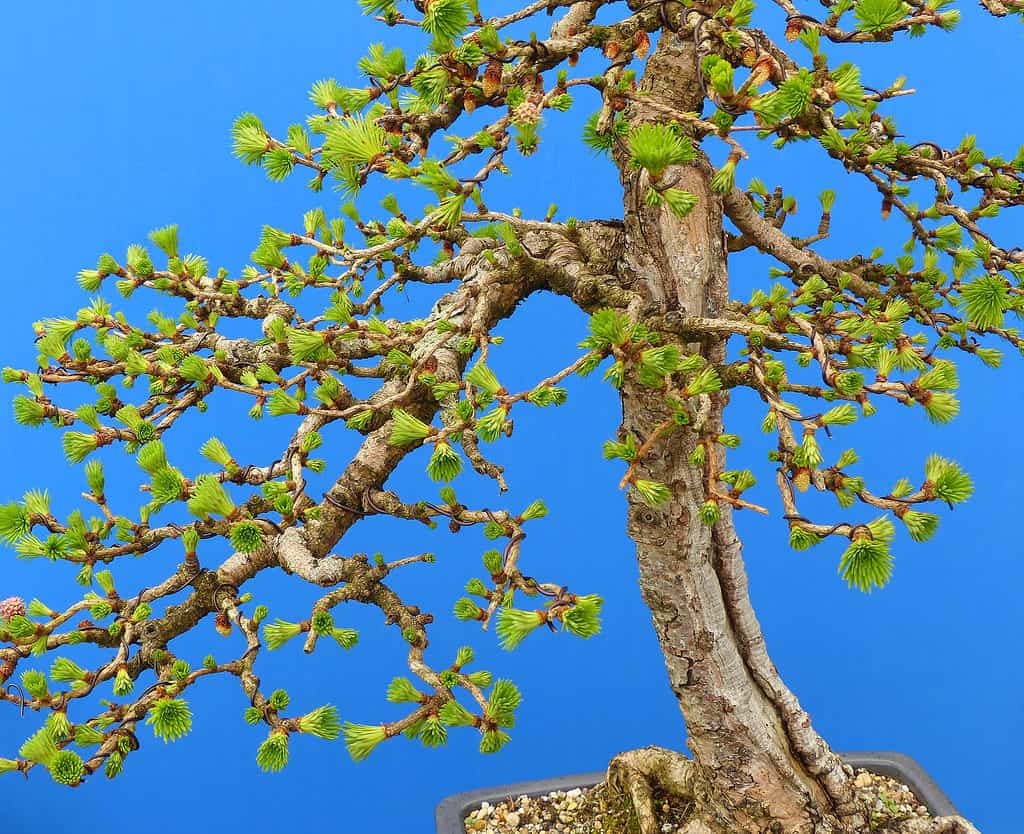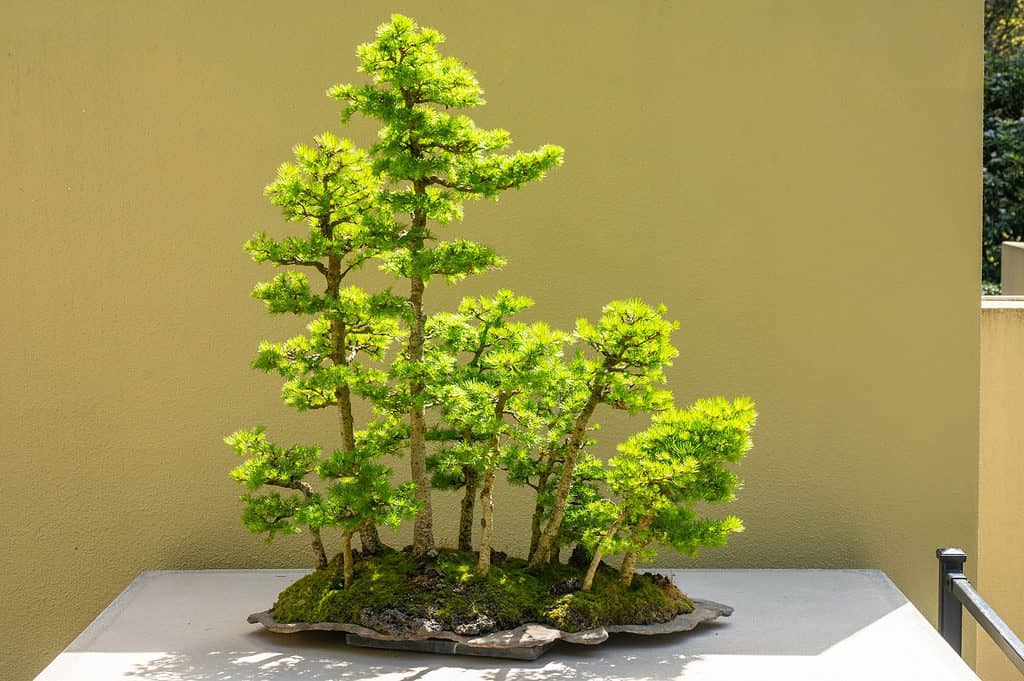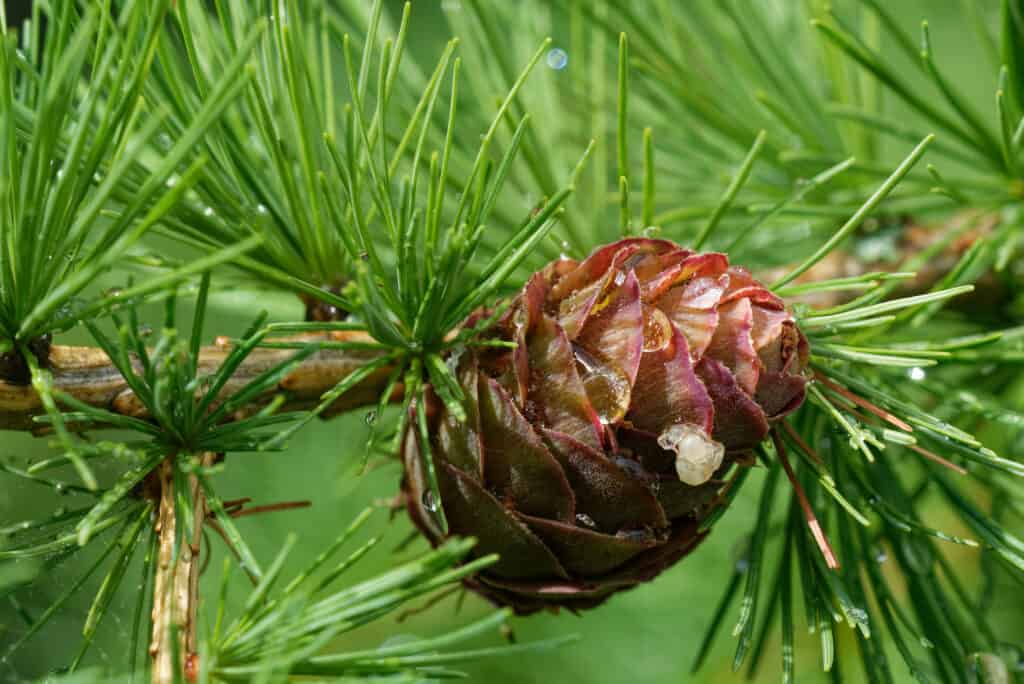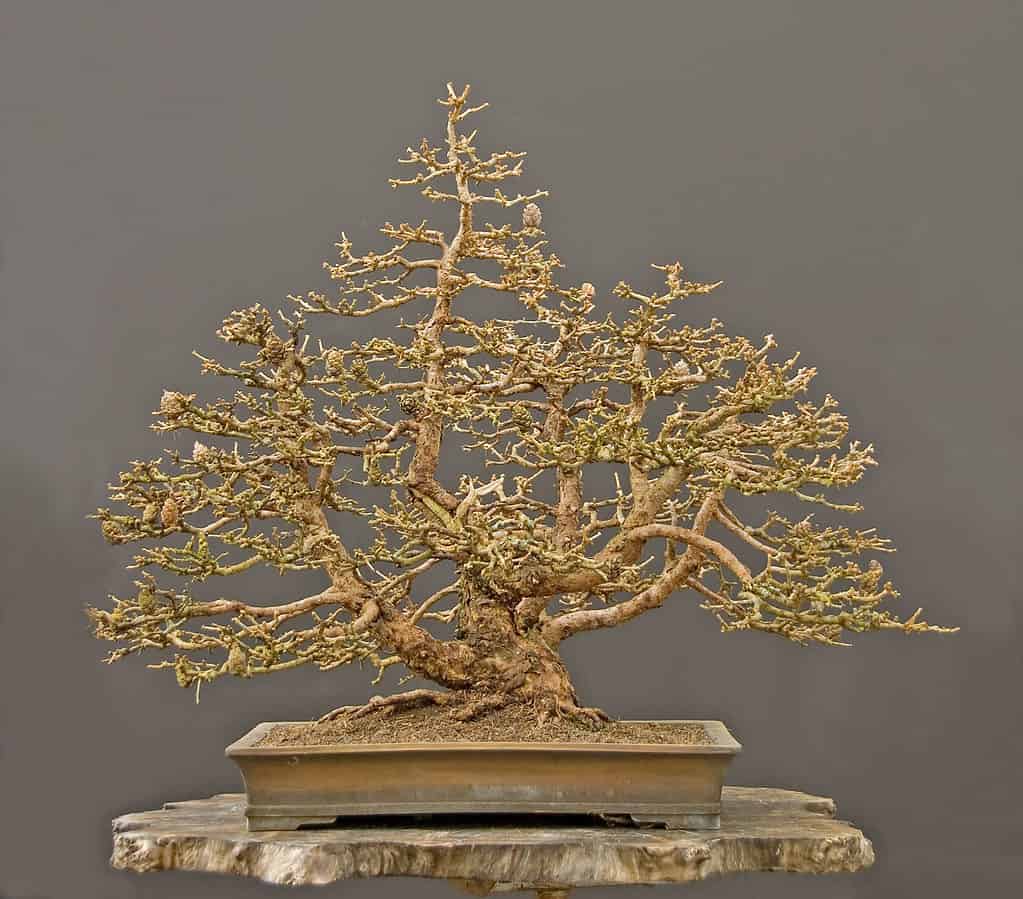Larch trees are known for being the rare conifer that loses its needles in the winter. Indeed, the needles of these trees turn yellow in the fall before they drop. This leads to some gorgeous fall foliage in the cold, northern forests in which they are found. This also makes for beautiful, and often dramatic, Bonsai tree art.
In this handy guide, we’ll go over everything you need to know about growing larch Bonsai trees!

The yellow needles of larch trees in the fall make for beautiful Bonsai tree art!
©Bernd Schmidt/Shutterstock.com
| Larch Bonsai Tree Information | |
|---|---|
| Botanical Name | Larix |
| Common Types | Weeping Larch, Dahurian Larch, Japanese Larch, Eastern Larch, Western Larch, Masters Larch, Sikkim Larch |
| Sunlight | Full sun to partial sun. Some larch trees cannot tolerate shade, while others need it in areas with warm or hot summers. |
| Soil | Moist to wet, well-draining. Acidic depending on the type. |
| Water | Thorough watering when the topsoil is dry. Be careful to not let the rootball dry out completely. |
| For Beginners? | Yes! Larch trees are tough and easy to care for under the right conditions. They take well to pruning and are flexible when they are young, making shaping easier. |
| Indoors or Outdoors? | Outdoors in cold environments. Indoors during hot summers or heavy rainstorms. |
| Pairs Well With… | Rocks and moss, other natural ornamentation |
Common Types of Larch Bonsai Trees

Easy to wire, larch Bonsai trees can be styled into a variety of shapes.
©Mick Harper/Shutterstock.com
Larch trees can be found all over the Northern Hemisphere, from the furthest reaches of Siberia to British Columbia in North America. These cold hardy trees are coniferous, yet their needles change color and fall off. This is different from most other coniferous trees, which are usually evergreen!
The genus, Larix, is generally split into two different groups: the North American species and the Eurasian species. In total, there are 14 different species of larch trees. Some of these have their own varieties and cultivars.
Read on to find out about the common types of larch trees that can be used for Bonsai tree art!
Weeping Larch
The weeping larch is native throughout central and southern Europe. The needles on these trees are bright green in the summer. During the fall months, they turn shades of yellow and eventually fall off. When planted in a garden, these trees are often shaped and styled which means that they are used to it. This makes them perfect candidates for Bonsai tree art!
These hardy trees can tolerate cold weather. They especially love cool summers. The weeping larch thrives best in full sun, though they tolerate partial sun as well. They also love moist to wet soil that is well-draining.
Dahurian Larch
Dahurian larch trees are native to eastern Siberia and the surrounding area; northeastern China, Mongolia, and North Korea. In fact, Dahurian larch trees are considered to be the northernmost tree. They grow in tundras at the very northern tip of Russia. Because they are indigenous to such cold areas, Dahurian larches do not take well to warmer, milder winters. They are extremely cold hardy.
In the wild, these trees can grow up to 120 feet tall. The bark on Dahurian larch trees starts out smooth when they are young. Its red-brown color eventually fades into gray with age, and the texture grows rougher too. The needles on Dahurian larch trees are light green in color. Before they fall off in the autumn months they are usually yellow or orange.
Dahurian larch trees love direct sunshine for at least 4 to 6 hours a day. As for soil, it should be moist, acidic, and well-draining.
Japanese Larch

The slender size of the Japanese larch makes it great for the many upright styles of Bonsai tree art.
©Mariusz S. Jurgielewicz/Shutterstock.com
These tall, slim trees are native to the islands of Japan. Their needles are bright green in the spring and summer. During the autumn months, they turn golden-yellow before they fall off. Japanese larch trees love sunshine. They need at least 4 to 6 hours of direct sunlight every day. They cannot grow in the shade. As for soil, Japanese larch trees need it to be moist. They seem to be very sensitive to drought.
Eastern Larch
Eastern larch trees are also known as tamarack trees. These cold hardy trees can be found in their native habitat, stretching as far north as Alaska and the northwestern territories of Canada. This range continues down into the northeastern portion of the United States. Eastern larches can be found as far west and south as the Great Lakes and the surrounding states.
The needles on these trees are a lovely blue-green during the spring and summer. In the autumn months, they turn an equally lovely golden-yellow. Then, they fall off.
Despite being found naturally in dry areas, Eastern larches love moist, wet, acidic soil. They thrive best in areas with cooler summers and colder winters. Eastern larches can grow beneath full sunshine or partial sunshine.
Western Larch

Western larch trees are tall and majestic, which makes them a beautiful choice for Bonsai tree art.
©iStock.com/HeitiPaves
These massive trees can reach heights of almost 200 feet, which is more than double the height of their eastern cousins. Western larch trees are especially common in the Cascade Range. This mountain range stretches from Northern California, up through the states of Oregon and Washington, and tapers off in British Columbia.
Like other larch trees, the needles on this tree are bright green during the spring and summer. They turn shades of golden-yellow in the fall before dropping.
Western larch trees need well-draining soil, as they are unable to grow in standing water. Like other larch trees, they love the sunshine but can grow beneath partial sun as well.
Sikkim Larch
The Sikkim larch tree is native to the Himalayan mountains. These trees can be found growing in Sikkim, Nepal, Bhutan, India, China, and Tibet. Sikkim larch trees are among the smallest of the larch trees. When planted naturally, they reach heights of 40 to 60 feet.
These hardy trees can tolerate freezing temperatures and enjoy cool summers. Sikkim larch trees, like others, enjoy the sunshine and moist, well-draining soil.
Caring for Your Larch Bonsai Tree

While larch trees are known for being frost-hardy, when planted in Bonsai containers they need to be protected from the worst of winter!
©Walter Pall/Shutterstock.com
Larch trees are relatively easy to care for, though they thrive best in cool or cold conditions. Read on to find out how to care for your larch Bonsai tree!
Sunlight
Larch trees love sunshine. Many types and varieties need full sunshine to really thrive, though they can grow beneath partial sunshine. Since most larches are inclined to cold weather, sometimes they need partial shade during warmer summers.
Soil Type
As a whole, larch trees love moist or wet soil that is well-draining. Some prefer acidic soil, others can survive in most soil conditions as long as they are moist and well-draining. Since specialty Bonsai tree soil mixes are designed to be well-draining, this means that most of these mixes will suit your larch Bonsai tree well!
Water
When planted naturally or growing in the wild, most larch trees are used to wet conditions. This is still true when growing larch trees as Bonsai trees. They need to be watered thoroughly whenever the topsoil is dry to the touch. Sometimes, in the summer, it can be a good idea to keep your larch tree in a shallow bowl full of water. This ensures that it gets enough water during the hot summer months.
If possible, try to avoid watering your larch Bonsai tree with hard water.
Placement
Since larch trees love sunshine, it is usually a good idea to place them somewhere they can receive lots of sun. This can pose a problem in the summer, especially if they are being grown in an environment that gets particularly hot, or dry. Larch trees prefer cool, damp summers but it can be possible to grow them in warmer conditions. Keep them in partial shade during the summer or even indoors next to a window.
Even though larches are known for being able to handle frost and freezing temperatures better than other trees, they do weaken when grown in Bonsai containers. This means that your larch Bonsai tree needs to be protected from dry winds and heavy rain in the winter. This can be achieved by putting your larch Bonsai tree in a garage, shed, or greenhouse.
Pruning Your Larch Bonsai Tree

If you want to become a Bonsai tree artist, you need the right tools for the job.
©Olena Antonenko/Shutterstock.com
Thankfully, larch Bonsai trees adapt to regular pruning fairly well. Read on to discover everything you need to know about pruning larch Bonsai trees!
To start, larger branches should only be pruned before the tree begins to grow. This is usually late winter through early spring. When removing buds, make sure they have not yet opened. Make sure to leave only a couple of buds on the twigs. In the summer, you can prune longer shoots. When they reach 4 to 6 inches, they can be trimmed back.
Ideal Larch Bonsai Tree Styles
In the wild, larch trees grow upright and slender. This can be mimicked in Bonsai tree art, though with enough patience and skill, larch Bonsai trees can also be shaped into more dramatic styles. Here are some of the most common, and ideal, larch Bonsai tree styles!
Since larch trees grow straight, any upright Bonsai tree style is ideal for these trees. Particularly the styles of Chokkan and Moyogi, known as the formal upright and the informal upright styles, respectively. Cokkan involves shaping the singular trunk of your tree as straight as possible. Moyogi involves taking on a more twisted shape, usually in the form of the letter S.
Another upright style that is ideal for larch Bonsai trees is that of the Yose-ue style. This style involves using multiple branches to create one large canopy. Larch trees are ideal for this style because their trunks are rather slender.
As for more challenging Bonsai tree styles, there are many options to choose from for your larch Bonsai tree. There is the Shakan style, in which the trunk of the Bonsai tree is angled. It leans to one side in a straight line.
The style of Hen-kengai can also be achieved with larch Bonsai trees with enough know-how and patience. Hen-kegai is also known as semi-cascade style. It involves growing the trunk normally for a few inches and then shaping it so it sweeps downward.
Propagating Your Larch Bonsai Tree

Larch Bonsai trees can be propagated two ways: from seeds or from cuttings.
©Walter Pall/Shutterstock.com
There are two options for propagating larch Bonsai trees. You can propagate them from seeds or from cuttings! If you choose the cuttings route, make sure that the cuttings are semi-hardwood.
Common Problems with Larch Bonsai Trees
Unfortunately, there are a number of pests and diseases that can harm your larch Bonsai tree. These pests include aphids, caterpillars, mealy bugs, bark beetles – especially their larvae – and saw fly. Diseases that can attack your larch Bonsai tree include needle cast and grey mold rot. Fortunately, these issues can usually be solved with specific pesticides.
The photo featured at the top of this post is © Mariusz S. Jurgielewicz/Shutterstock.com
Thank you for reading! Have some feedback for us? Contact the AZ Animals editorial team.






